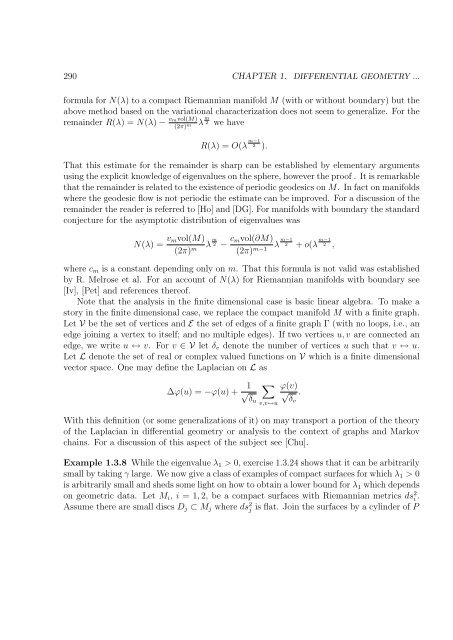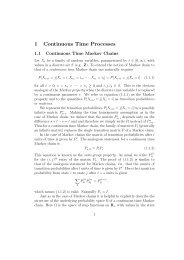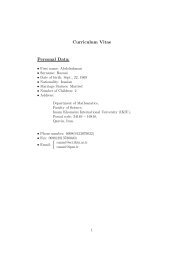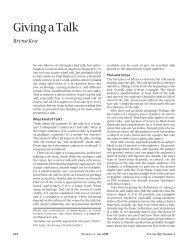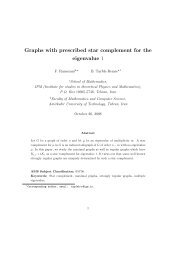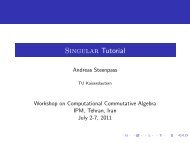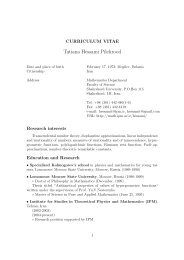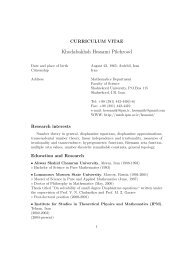Chapter 1 DIFFERENTIAL GEOMETRY OF REAL MANIFOLDS
Chapter 1 DIFFERENTIAL GEOMETRY OF REAL MANIFOLDS
Chapter 1 DIFFERENTIAL GEOMETRY OF REAL MANIFOLDS
You also want an ePaper? Increase the reach of your titles
YUMPU automatically turns print PDFs into web optimized ePapers that Google loves.
290 CHAPTER 1. <strong>DIFFERENTIAL</strong> <strong>GEOMETRY</strong> ...<br />
formula for N(λ) to a compact Riemannian manifold M (with or without boundary) but the<br />
above method based on the variational characterization does not seem to generalize. For the<br />
remainder R(λ) = N(λ) − vmvol(M)<br />
(2π) m λ m<br />
2 we have<br />
R(λ) = O(λ m−1<br />
2 ).<br />
That this estimate for the remainder is sharp can be established by elementary arguments<br />
using the explicit knowledge of eigenvalues on the sphere, however the proof . It is remarkable<br />
that the remainder is related to the existence of periodic geodesics on M. In fact on manifolds<br />
where the geodesic flow is not periodic the estimate can be improved. For a discussion of the<br />
remainder the reader is referred to [Ho] and [DG]. For manifolds with boundary the standard<br />
conjecture for the asymptotic distribution of eigenvalues was<br />
N(λ) = vmvol(M) m<br />
λ 2 −<br />
(2π) m cmvol(∂M)<br />
(2π)<br />
m−1<br />
λ 2 + o(λ m−1 m−1<br />
where cm is a constant depending only on m. That this formula is not valid was established<br />
by R. Melrose et al. For an account of N(λ) for Riemannian manifolds with boundary see<br />
[Iv], [Pet] and references thereof.<br />
Note that the analysis in the finite dimensional case is basic linear algebra. To make a<br />
story in the finite dimensional case, we replace the compact manifold M with a finite graph.<br />
Let V be the set of vertices and E the set of edges of a finite graph Γ (with no loops, i.e., an<br />
edge joining a vertex to itself; and no multiple edges). If two vertices u, v are connected an<br />
edge, we write u ↔ v. For v ∈ V let δv denote the number of vertices u such that v ↔ u.<br />
Let L denote the set of real or complex valued functions on V which is a finite dimensional<br />
vector space. One may define the Laplacian on L as<br />
∆ϕ(u) = −ϕ(u) + 1<br />
√ δu<br />
<br />
v,v↔u<br />
ϕ(v)<br />
√ .<br />
δv<br />
With this definition (or some generalizations of it) on may transport a portion of the theory<br />
of the Laplacian in differential geometry or analysis to the context of graphs and Markov<br />
chains. For a discussion of this aspect of the subject see [Chu].<br />
Example 1.3.8 While the eigenvalue λ1 > 0, exercise 1.3.24 shows that it can be arbitrarily<br />
small by taking γ large. We now give a class of examples of compact surfaces for which λ1 > 0<br />
is arbitrarily small and sheds some light on how to obtain a lower bound for λ1 which depends<br />
on geometric data. Let Mi, i = 1, 2, be a compact surfaces with Riemannian metrics ds 2 i .<br />
Assume there are small discs Dj ⊂ Mj where ds 2 j is flat. Join the surfaces by a cylinder of P<br />
2 ,


